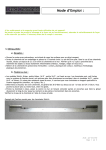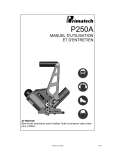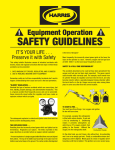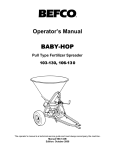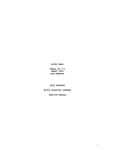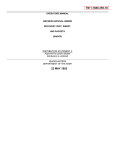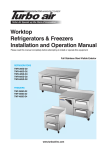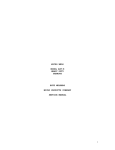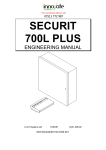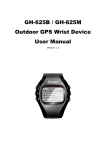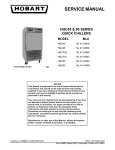Download j3, j4 butt welders - Micro Products Company
Transcript
MICRO PRODUCTS COMPANY MANUFACTURERS OF PRECISION WELDING MACHINES J3, J4 BUTT WELDERS SERVICE MANUAL 1 TABLE OF CONTENTS 1.0 2.0 3.0 4.0 5.0 6.0 7.0 8.0 9.0 10.0 11.0 12.0 13.0 SPECIFICATIONS GENERAL HOOK-UP INSTRUCTIONS GENERAL OPERATING INSTRUCTIONS SUGGESTED SETTINGS TYPICAL OPERATING SEQUENCE ANNEALING INFORMATION SPECIAL ADJUSTMENTS PREVENTATIVE MAINTENANCE DIAGNOSTIC CHART FOR TROUBLE-SHOOTING ELECTRICAL SCHEMATIC SAFETY REMINDERS BUYERS GUIDE PARTS LIST 1.0 SPECIFICATIONS Stock Size Range, Diameter Material Standard Operating Voltages Input Power Cycle Line Demand, 115 volts * Line Demand 230 volts * Heat Selection Switch w/high-low Range Switch 50% duty cycle rating DIMENSIONS AND WEIGHTS 4-Wheel Truck Mounted Floor Space Welding Die Height Height Overall Welder Weight Model J3C .032” to .064” (.81mm1.588mm) Model J4C .064” to .128” (1.62mm3.25mm) Model J3S .020” to .080” (.51mm-2mm) Model J4S .040” to .160” (1mm-4mm) Copper & EC Aluminum Copper & EC Aluminum Steel, Alloy, Stainless Steel, Alloy, Stainless Model J4Sf .004” sq to .030” Sq (2.58mmsq. to 19.35mmsq) Cross sectional Steel, Alloy, Stainless 230 Volts 115 Volts 230 Volts 115 Volts 230 Volts 115 Volts 230 Volts 115 Volts 230 Volts 115 Volts 60 24 77 12 38 60 24 77 12 38 60 9 29 5 15 60 9 29 5 15 60 24 77 12 38 Hertz amps@100% amps@10% amps@100% amps@10% Hertz amps@100% amps@10% amps@100% amps@10% Hertz amps@100% amps@10% amps@100% amps@10% Hertz amps@100% amps@10% amps@100% amps@10% Hertz amps@100% amps@10% amps@100% amps@10% 4 Point 4 Point 10 Point 10 Point 4 Point 4 KVA 4 KVA 1.5 KVA 1.5 KVA 4 KVA 2 Stationary Casters 2 Swivel Casters 24” x 24” (61cm x 61cm) 2 Stationary Casters 2 Swivel Casters 24” x 24” (61cm x 61cm) 2 Stationary Casters 2 Swivel Casters 24” x 24” (61cm x 61cm) 2 Stationary Casters 2 Swivel Casters 24” x 24” (61cm x 61cm) 2 Stationary Casters 2 Swivel Casters 24” x 24” (61cm x 61cm) 41” (104cm) 53-1/2” (136cm) 180Lbs(82 Kg) 41”(104cm) 53-1/2” (136cm) 180Lbs(82 Kg) 41”(104cm) 53-1/2” (136cm) 180LBs(82 Kg) 41”(104cm) 53-1/2” (136cm) 180Lbs(82 Kg) 41”(104cm) 53-1/2” (136cm) 180lbs(82 Kg) * Other voltages available 2 2.0 GENERAL HOOK-UP INSTRUCTIONS 2.1 ELECTRICAL First Determine that available electrical service in your plant corresponds to the nameplate rating located on the welder housing. Electrical wiring to the welder must be of sufficient size to deliver full ampere load with no appreciable loss during the weld cycle. The welder will not operate properly if there is more than a 10% variation in the line voltages. In general, the welder should be fused with a slow blow fuse of the 100% duty cycle rating. The minimum power cable size to the welder can be obtained by using this same current rating. Refer to the National Electric Code and local electrical regulations for adequate power sizes; disconnect methods, and fusing guidelines. Remember, line voltages to the welding machine are potentially dangerous should the power cords be damaged or severed. The welding voltages at the welding dies will not harm an operator, since they do not exceed 5 volts. 2.2 SAFETY PRECAUTIONS 2.2.1 ELECTRICAL Maintain electrical cable to welder in good repair. Welder must be grounded and connections securely tightened. Heat switch must not be changed to new position while a weld cycle is in process. Disconnect electrical service before servicing welder – high voltages are located within the base of the welder. 2.2.2 MECHANICAL Safety glasses must be worn by operator while using welder. Keep all safety guards on welders and use properly. Operators must be instructed on basic operation of unit to prevent injury. Check nameplate rating and keep within material size range for each welder. 3 2.3 WATER It is important that if a welder is to be operated for an extended period of time and headpieces heat up, water lines must be connected. On most model J series Micro-Weld welders, water-cooled headpieces are an option, which can be added at our factor. Connect hoses to inlet and outlet provided at the back of the welder. A shut-off should be installed in the inlet line, and the hose from the outlet should run to an open sight drain. Water should only flow during the weld cycle and the temperature of the water at the drain should feel hot to the hand. This will prevent condensation on the welder headpieces, which could drip on the welding transformer and cause it to ground out. 2.4 AIR Air operated model J series Micro-Weld welders are an option. Should you have this option, air operation cylinders require a 90 P.S.I. air source. An air regulator will be provided to set the minimum amount of pressure needed for the material being welded. 4 3.0 GENERAL OPERATING INSTRUCTIONS BASIC OPERATING PARTS 3.1 WELD HEAT SELECTION This setting determines the amount of heat available for welding. Because of considerable variations in voltage and power factors in various plants, and wide variety in material composition, exact heat setting cannot be specified. In general, larger sizes of stock use higher heat settings. Welding heat is selected by means of a heavy-duty switch and, on some models, a high-low range switch. See tale 1. The heat switch is conveniently located on the left side of the welder. Number 1 indicates high heat, number 4 or 10 indicates low welding heat. Other numbers are equally graduated from high to low to allow just the right amount of voltage for the welding operation. On models with the high-low range switch, it is located on the front right, just below the nameplate. The range switch sets the range of the heat switch with the low range settings picking up where the high range settings leave off. The heat or range switch should never be changed to a new setting during a welding operation. Table 1 Model J3C J3S J4C J4S J4SF 3.2 Heat Switch Settings 4 10 4 10 4 H/L Range Yes Yes Yes Yes No SPACING MECHANISM The welder is capable of welding a variety of material sizes, but each major change in material size requires a corresponding change in the open space of the jaws. Spacing is obtained by rotating the space-adjusting knob located on the lower right side of the headpiece housing. The spacing knob determines the amount of weld upset and expelled metal projecting from the weld zone. 5 3.3 UPSET PRESSURE MECHANISM Upset pressures are required for all weld operations. The model J series of Micro-Weld welders obtains its pressures form unique spring assemblies located on the clamp arms. The upset pressures are completely adjustable for various sizes and types of materials. Adjustment of the clamp spring pull determines the amount of upset pressure for the weld forging process. This is obtained by adjusting the length of the pull bar by rotating the tension disc on the foot pedal assembly. Number 1 denotes the greatest upset pressure. 3.4 FLASH SPEED MECHANISM On model J4SF welder, precise flashing speed regulation and final upset drop off is obtained from its unique hydraulic cylinder located on the right of the weld head. Flashing speed is set with the use of the flashing speed adjusting knob, which regulates the speed of the oil passing the internal valve. Number 1 indicates the slowest flashing speed. Turn the knob counterclockwise to increase the flashing speed. Generally, larger stock requires a slower flashing speed. Final upset is obtained when the piston is compressed to a point where the internal valve is bypassed allowing unrestricted movement. This bypass point can be adjusted by rotating the piston cap clockwise causing the unrestricted movement of the piston to begin when the welding dies are closer together. Properly made welds are perfectly sound and have little upset burr. Poor welds usually indicate too low heat or incorrect flashing speeds. 3.5 WELDING DIES AND DIE SHOES Welding dies serve three purposes: (1) to carry current and voltages for welding, (2) to align material ends, and (3) to prevent slippage during the weld cycle. Small wire must be placed into small grooves and large wire into the large grooves. Flat stock must be placed against the stop in the rear of the dies. The die shoe holds the material securely into the lower welding die during the weld process. 3.6 HAND SHEAR An accessory hand shear may be affixed to welder to assist in trimming waste materials prior to welding. Several types are available from Micro Products Company. 6 3.7 FILING VISE Accessory machinist vises or special Micro-Weld vises are available to assist the operators to hold wire during deburring operations. 3.8 ANNEALING DEVICES Three types of annealing devices are available to assist in processing weld zones, which may have become brittle during the weld cycle. They are: (a) Standard anneal, used on non-ferrous types of material or on low carbon steel wire. (b) Front anneal, used on low, mild steel applications, and (c) dial indicating anneal, used on high carbon steel wire. 3.9 FOOT TREADLE MECHANSIM The model J series Micro-Weld wire and rod welders are activated by using a foot treadle device, which performs the welding sequence. The manual foot treadle may be replaced with an air-activated mechanism so that the operator just has to move his foot slightly to activate the weld process. Some welding advantage is gained in weld quality by using the air-upset mechanism since all activating strokes are exactly the same. All operations on the Micro-Weld model J series, wire and rod welders are performed by a single down-stroke of the treadle mechanism, when the treadle is released, the operating parts are automatically re-spaced, ready for the next weld operating. Blind guides can be designed for handicapped people. 7 4.0 SUGGESTED SETTINGS Size J4SF Welder (flat stock) .021” x .275” .042” x .514" Stock Oil Cylinder Space Heat Tension Steel Steel 7 4 7 9 4 2 1 1 APPROXIMATE SETTINGS TO AID IN OBTAINING HIGH QUALTY WELDS Stock Steel Copper Steel Copper Size .020” .050” .080” .032” .040” .050” .064” .040” .060” .080” .100” .160” .128” .102” .080” .064” Heat 6 4 1 4 3 2 1 10 8 6 4 1 1 2 3 4 Space 5 7 9 3 4 5 6 3 4 5 6 9 9 7 6 5 Grooves Front Middle Rear Front Middle Middle Rear Front Middle Middle Rear Rear Rear Rear Rear Middle Tension 1 1 1 3 3 3 3 3 3 3 1 1 1 1 1 3 Range Low Low Low Low Low Low Low High High High High High High High High High Type Welder J3S J3C J4S J4C Welders used for E.C. aluminum may use approximately the same settings as copper. 8 5.0 TYPICAL OPERATING SEQUENCE J3C, J4C & J3S, J4S Remember: Material to be joined must be free of rust, corrosion, or other insulating material where it contacts welding dies. 1. Cut wire ends to best joint configuration. See figure 1. 2. Set open space for proper die opening. 3. Select proper weld heat and range. 4. Place wire into welding dies so the ends touch midway between the welding dies. 5. Push foot treadle down far enough to hold material in place in dies. 6. Close flashguard. 7. Push foot treadle down to bottom of stroke to finish clamp process and start weld process. 8. Heat is imparted to wire ends through faying surfaces. 9. Movable platen, under upset pressures, moves toward a closed position due to loss of compression yield strength of wire. 10. A weld limit switch terminates electrical power flow through wire. 11. Actual weld is formed after electric power flow stops, and material is hot forged together with remaining upset pressure. 12. Welded material quickly cools under pressure. 13. Remove stock from dies by releasing foot treadle. 14. Anneal weld zone and sections on either side, if applicable. 15. Remove upset burr so the enlarged weld area is equal in diameter to the parent metal size. 9 J4SF 1. Cut material ends to best joint configuration. See Figure 2. 2. Set open space for proper die opening. 3. Set flashing speed 4. Select proper weld heat. 5. Place material into weld dies so the ends touch midway between the welding dies; also, flat stock should be against the rear stops in the dies. 6. Push foot treadle down far enough to hold material in place in dies. 7. Close flashguard. 8. Push foot treadle down to bottom of stroke to finish the clamping process, and start weld process. 9. Heat is imparted to the material end through faying surfaces. 10. High current flow causes flashing 11. Movable platen, under controlled speed and pressure, moves toward a closed position, due to flashing, until the faying surfaces are covered with molten metal, and a short length of each part reaches forging temperature. 12. When the movable platen reaches a preset point, flashing speed is terminated, and upset pressure is applied. 13. Further movable platen travel then activates the weld limit switch, and electrical power flow through the material is terminated. 14. Actual weld is formed after electric power flow stops, and material is hot forged together with remaining upset pressure. 15. Welded material quickly cools under pressure. 16. Remove stock from dies by releasing foot treadle. 17. Anneal weld zone and sections on either side, if applicable. 18. Remove upset burr so as the enlarged weld area is equal to the parent metal size. 10 Examples of good welds (picture) 11 5.1 ANNEALING INFORMATION An anneal operation will be required on hard drawn or carbon steel wire and rod. Annealing will accomplish tow things: (1) normalize the grain structure in the weld zone, (2) will soften sections on either side of the immediate weld area. To anneal, follow directions of one of the following methods, which is applicable to your welder. 5.2 STANDARD TYPE ANNEAL DEVICE With standard type anneal device cam anneal clamps attached directly to movable and stationary welding platens with “L” shaped brackets or similar devices. Used on welders suitable for welding non-ferrous and low carbon steel wire and rod. A. Close safety flashguard if equipped with interlocking switch. B. Place welded stock into anneal clamps with upset burr midway between anneal clamps, clamp securely into position. C. Push annealing switch with a jogging action to heat material to desired temperature. D. After the material has lost its color, carefully remove the wire from the anneal jaws and remove the upset burr. Be extremely careful not to get burned on the hot metal. 5.3 FRONT OR DIAL INDICATING ANNEAL DEVICES A cam type clamp anneal located beneath the welding dies. One clamp is stationary and the other is movable clamp which is attached to a unique mechanism which allows the hot, expanding and annealing wire to remain straight without the normal bowing or bending. This feature assists in preventing fractures in weld zone during anneal process. Both type of devices, front or dial type, are suitable for low carbon steel, mild steel, stainless steel and high carbon steel. 12 5.4 FRONT TYPE ANNEAL, OPERATING PROCEDURES A. Close safety flashguard, if so equipped. B. Place welded stock into anneal clamps with upset burr midway between anneal jaws, being careful to push movable clamp jaw against its inward stop. Carefully tighten wire into both jaws. C. Push anneal switch in a jogging fashion, to evenly heat up weld area to desired anneal temperature. D. Let annealed are cool. E. After the wire has lost its color, carefully remove the wire from the anneal jaws and remove the upset burr. F. Be careful not to get burned on the hot metal. 5.5 DIAL INDICATING ANNEAL DEVICE OPERATING PROCEDURES A. Proceed as instructed on front type anneal and proceed with the following information. B. When heat is applied to the wire, the heated wire will expand. C. The dial indicator will start to move as the wire begins to heat up. D. When the exact anneal temperature is reached, the rotating needle on the dial indicating device will momentarily stop. E. In sequence, the needle will drop back slightly, and then start to move forward again. F. At the start of the second forward movement of the needle, release the anneal switch. G. Heating the wire beyond this pint, will cause an improperly treated anneal zone. H. Allow wire to cool down below 1000 degrees F., before removing wire from the anneal clamps. (Loss of coloring to wire) I. Be extremely careful of hot metal during handling procedures. 13 5.6 DETERMINING CORRECT ANNEAL TEMPERATURES The critical temperature of carbon steel wire is also the maximum heating temperature for the annealing process associated with the butt-welding procedures. The critical temperature will vary slightly, but in direct proportion to the wire’s carbon content. Since carbon steel is ferromagnetic, the exact annealing temperature can be easily determined by the loss of magnetic qualities at that point. To expand this process further, a wire that is gradually heated to a point of just beginning to show some color is very close to the correct anneal temperature (about 1000 degrees F). At this point, the jogging off-on of the anneal switch is important, so that when we test the annealing area with a magnet during the off period it will not be drawn to the wire surface due to electrical magnetic flux. When the magnet does not attach to the wire surface, the correct anneal temperature has been achieved. We are looking for the exact point of loss of magnetic qualities, so do not over heat the material beyond this point. Annealing after welding to enable an operator to draw carbon steel wire is very important for the wire mill and certain techniques have been developed by others which may assist in drawing high carbon steel wire. Possibly the methods described here will be beneficial to your operation. 5.7 ANNEALING ALUMINUM WIRE AND ROD Annealing aluminum rod and wire can be somewhat difficult since it passes very quickly through the plastic rang and blows apart. Be extremely careful not to get burned from expelled aluminum by poor safety techniques. A good anneal temperature for aluminum rod and wire is approximately 700 degrees F. Common blue carpenters chalk rubbed on the surface to be annealed will assist in obtaining this temperature. The chalk will turn a straw color at the anneal temperature 700 degrees F. 14 6.0 SPECIAL ADJUSTMENTS HEADPIECES Refer to Figures 4 through 7 6.1 SPACE ADJUSTING KNOB Determines the amount of open space between the welding dies. Calibration: 1. Turn space-adjusting knob to the stop or the number 1 setting. 2. Lay a straight edge across the die seats. 3. The die seats should be level and the weld dies should have 1/32” between the closest die edges. 4. If die seats are not level: A. Back headpiece close stop screw off of nylon stop pad. B. Loosen the setscrew on the space-adjusting knob. C. With a pair of pliers, turn the space-adjusting shaft until dies are level and proper clearance between dies exists. D. Retighten spacing knob so that the arrow pointer is across from #1. 5. A compression spring and stop pin are located beneath the spacing knob to assure repeatable positions and overthrow protection. Check to make sure spacing knob has pressure applied to it from this spring and pin is not bent or missing hence preventing proper adjustment, replace as required. 6.2 HEADPIECE CLOSED ADJUSTMENT Prevents welding dies from touching, and prevents possible over travel of movable platen. Calibration: 1. Turn space-adjusting knob to the stop at the number 1 setting. 2. Adjust closed stop adjusting screw so that when the movable head is pushed by hand, to a closed position, the weld dies will not touch, and there is approximately 1/64” at #1 setting. 3. Tighten locknut. 15 6.3 WELD LIMIT SWITCH Determines the timing point of the weld cycle. Adjustments: 1. The limit switch is adjusted for actuation by a hex-head bolt, which contacts the limit switch plunger. The weld dies will be used as a reference point to obtain the adjustment. 2. Loosen the limit switch adjusting screw locknut. 3. Set open space adjusting knob to approximate #4. 4. Slowly turn space-adjusting knob clockwise toward #1 until the hex-head bolt activates the limit switch. 5. There should be 1/16” between the closest die edges. 6. If the gap is greater than this screw bolt in to activate the switch later. If the gap is less than 1/16” then screw the bolt out to activate the switch sooner. Repeat steps 3 and 4 after making bolt adjustments until step 5 is achieved. 7. Tighten locknut. 8. The limit switch remains the same for all wire sizes, but can be used for a vernier control of heat in extreme cases to add or subtract slight amounts of heat to assure levelness of welded material. Figures 4-5-6-7-8-9-9A-10 16 17 18 19 6.4 HYDRAULIC CYLINDER Refer to Figures 8. For new type cylinder see addendum. CONTROLS THE FLASHING SPEED AND UPSET POSITION Calibration: 1. Set closed stop adjusting screw to stop movable head when dies are 1/32” between closest die edges. 2. To set unrestricted movement of hydraulic cylinder to begin when dies are 3/32” apart; A. If unrestricted movement starts at a greater distance: 1. Loosen lock nut on piston cap. 2. Rotate cap clockwise to make unrestricted movement of piston to begin when welding dies are closer together. 3. Tighten locknut on piston cap. B. If unrestricted movement starts at a lesser distance: 1. Loosen lock nut on piston cap. 2. Rotate cap counterclockwise to make unrestricted movement of piston begin when welding dies are further apart. 3. Tighten lock nut on piston cap. 3. Set limit switch to cut-off weld current 1/32” after unrestricted movement has begun. 6.5 CLAMP SPRING AND UPSET PRESSURES Refer to Figure 9 UPSET PRESSURE Determines the amount of clamping and upset pressure available for weld process, by making pull bar longer or shorter. Calibration: 1. With nothing in welding dies, depress foot treadle. 2. With a straight edge, determine that bolts A,B,C and D are all in alignment. Lengthen or shorten pull bar to attain this setting. This alignment sets the welder for maximum pressures. 3. Should you require lesser pressures for smaller wire sizes, the pull bar can be lengthened to decrease pressure as per the following: (See figure 9A) A. Loosen hand wheel on the foot pedal assembly. B. Rotate disc so number on disc lines up with notch on back-up plate. C. Tighten hand wheel. 4. Lesser pressures are indicated when center bolts; B and C are above the centerline. 20 5. Do not shorten the pull bar to such a position so that the center bolts B and c are below the centerline. Clamp spring breakage could occur. 6. Pressures should not be increased or decreased by cross bolt adjustments. Important: Do not turn or remove the front center pivot screw and nut. To remove the movable half of the weld head as specified in the preventive maintenance techniques, loosen and remove the rear center pivot only. 6.6 CLAMP SPRING CROSS BOLT Refer to Figure 10 Assures maximum die shoe opening and non-shorting of weld head when annealing. Calibration: 1. Adjust cross bolt on clap arm on the stationary head to where the clamp arm just contacts the weld die seat and approximately 1/16” to 1/8” clearance is evident between the clamp spring clevis and weld die seat. 2. Adjust cross bolt on clamp arm on the movable head to where the clamp arm just contacts the weld die seat. 3. Tighten lock nuts. 21 7.0 PREVENTATIVE MAINTENANCE Keep in mind that these welders are precision built to last many years, but will require good maintenance procedures. They are designed to be as automatic as possible with a minimum dependence on the ability of the operator. Adjustments must be made by those thoroughly familiar with the operating principles of the welders. 7.1 AS REQUIRED 1. Remove flashings and loose particles from welding headpieces to prevent accumulation. Use a soft brush and a soft metal scraper. 2. Check condition of welding dies and welding die shoes, replace as required. 3. Check condition of clamp spring assemblies and replace all broken springs, springs that have taken a set as well as worn fiber bushings and washers. 7.2 QUARTERLY 1. Repeat above items. 2. Check anneal dies and replace all worn parts. 3. Check for worn bearings and elongated holes on foot treadle assemble and pull rod parts. 4. General lubrication of all moving parts. 7.3 ANNUALLY 1. Repeat above noted items. 2. Check for worn or poorly aligned contacts within magnetic contactor. (Some older Model J3 and J4 series units do not have contactors.) 3. Clean weld transformer secondary strap connects to movable headpiece. Emery cloth works well to bring all surfaces in this area to a bright and shiny condition. Retighten completely. 4. Check for excessive wear in clamp arm assemblies, where die shoes fit into clamp arm openings. Replace as required. 5. Remove movable welding headpiece by loosening rear pivot centers. Check the condition of the pivot center surfaces, polish and thoroughly clean. Re-lubricate and re-install movable headpiece and adjust so that the movable headpiece do not have any side play. Headpiece must be free to pivot and die seat surfaces must be in good alignment. 6. Check headpiece castings, if worn, replace. Should the welders be used in a corrosive atmosphere, clean off oxides and repaint as required. 22 8.0 WELDING DIES AND DIE SHOES INFORMATION Description: Welding dies – Lower conducting electrode and clamp jaw Weld die shoes – Upper clamping member Welding dies and die shoes in poor condition are the main causes of bad welds. Care of die sets: 1. Use a brass or fiber blade to remove particles of flashings that build-up on die sets. Excessive flash build-up causes die burns on material and shorting of die sets. 2. Do not attempt to clamp material that is not suited for welder into die sets. Undersized materials will slip and burn die grooves. Oversized materials will overstress clamping parts. 3. Do not use welding die sets for a vise. These parts will not withstand the mechanical abuse. 4. Whenever welding dies are replaced, clean bottoms of dies and corresponding die seats to a bright and clean condition before bolting them tightly into place and oxidize surface will insulate the welding dies and reduce effective welding voltage. 5. Welding die shoes must swivel freely within the clamp arm pivots to prevent cracking of die shoes. File down die shoe boss if necessary. 6. Welding die set will wear with use and must be changed occasionally for good welding results. Keep an adequate supply of replacement parts available. Wire and rod slippage is a problem caused by poor die sets and a major cause of wire breaks. Types of welding die shoes picture 23 9.0 DIAGNOSTIC CHART FOR TROUBLE-SHOOTING WELDING ACTION Weld action normal but weld burr doesn’t extend beyond wire Molten metal is blown out and ends not joined Weld area heats up but weld is not complete Weld has complete burr but is dry and breaks off below surface of wire CAUSE REMEDY Lack of open space Increase open space until desired burr is obtained Lower heat settings Set limit switch properly Check size rating of welder Replace clamp springs Increase weld heat Clean and tighten transformer connections Clean welding dies and surfaces Decrease starting space Lower upset pressure Reset limit switch to specifications Carbon-steel wire often appears like this, process wire by annealing weld before removing burr Replace worn dies and shoes Decrease starting space Return heads to factory Decrease upset pressure Increase weld heat Worn dies and shoes Check electric lines Clean and tighten transformer connections to heads Clean rod where clamped in dies Replace dies and shoes Clean build-up of flash materials Weld heat too high Weld limit switch Stock is too small Weak clamp spring Low heat Secondary transformer connections Loose or dirty welding dies Starting space adjust Upset pressure too great Limit switch settings High carbon steel wire Welds good but poorly aligned Ends of wire buckle and may not weld Varying weld results Welding dies & die shoes Starting space Loose pivot centers Upset pressure too great Low weld heat Stock slipping Varying weld voltages Rod condition variations Dies and die shoes Flashings Rod cuts Weld contactor Check contactor for poor contacts 24 9.1 ELECTRICAL TROUBLE-SHOOTING OF WELDER (Caution!! Extreme care should be exercised when making these tests. Dangerous voltages are present in the welder. Only persons familiar with electrical safety precautions should perform these tests.) 9.1.1 TROUBLE-SHOOTING TABLE (see section 9.1.3 and 9.1.4) This electrical trouble-shooting table is furnished as a suggested method of trouble-shooting the welder. The individual steps of the table should be performed in the order given, to make the test valid. The electrical schematic (section 10) furnished for these tests shows the table test points. This table may be used for welders with a different but closely related wiring by using corresponding test points. During all tests, line voltage should be connected to L1 & L2 of the welder. The heat switch should be set to the #1 position. 9.1.2 FINAL ELECTRICAL CHECKS Set the heat switch to the number 1 position, connect the voltmeter across the welding dies. Press the operating switch. The meter reading will typically be less than 10 VAC. Consult the weld specification sheet for this value. Rotate the heat switch through all settings. If the voltage is not read at any setting, the heat switch may be defective. Actuate the weld limit switch; observe the reading goes to zero. Release the weld limit and operating switches, the reading should remain at zero. 25 9.1.3 MODEL J3 & J4 - 115 VOLT TABLE – Use Schematic B3275B TEST LEAD CONNECTION L2 FU1-1 L2 FU1-2 METER READING 115 VAC 115 VAC L2 L2 L2 L2 FS1-1 FS1-2 FS2-1 FS2-2 115 115 115 115 L2 L2 L2 L2 L2 L2 LS1-1 LS1-2 CR1-1 CR1-2 S1-1 CR2-2 VAC VAC VAC VAC 115 VAC 115 VAC Line voltage Line voltage Line voltage Line voltage PROBLEM IF NO READING Bad fuse connection Open fuse Open wire to operating switch Bad operating switch Open wire to anneal switch Open anneal switch Open wire to weld limit switch Bad weld limit switch Open wiring to contactor Bad contactor Open wire to heat switch Bad contactor PRESS OPERATING SWITCH WELD LIMIT SWITCH ACTUATED PRESS ANNEAL SWITCH X X X X X X X 9.1.4 MODEL J3 & J4 – 230 VOLT TABLE – Use Schematic B5741A X1 X2 X2 FU1-1 X2 FU1-2 115 VAC 115 VAC 115 VAC X2 X2 X2 X2 115 115 115 115 X2 X2 L2 L2 L2 L2 FS1-1 FS1-2 FS2-1 FS2-2 LS1-1 LS1-2 CR1-1 CR1-2 S1-1 CR2-2 VAC VAC VAC VAC 115 VAC 115 VAC Line voltage Line voltage Line voltage Line voltage Bad control transformer(T2) Bad fuses connection Open fuse Open wire to operating switch Bad operating switch Open wire to anneal switch Open anneal switch Open wire to weld limit switch Bad weld limit switch Open wiring to contactor Bad contactor Open wire to heat switch Bad contactor X X X X X X X Note: to perform repairs consult section 13 for parts identification 26 10.0 ELECTRICAL SCHEMATIC 27 11.0 SAFETY REMINDERS The following accident prevention information is presented to eliminate potential hazards while operating, inspecting or repairing Micro-Weld electric resistance welding equipment. Important safety compliance information for Micro-Weld Welders. GENERAL 1. Prior to using equipment, an operator must be instructed on basic operation and malfunction methods, by qualified personnel. 2. Safety eyeglasses must be worn by all personnel operating or servicing welders. 3. Use safety equipment properly and keep safety equipment on welders. 4. Determine that both operating voltages and hertz (cycles) of power supply correspond to ratings listed on weld nameplate located on weld housing. 5. Check nameplate ratings and keep within capacities and material categories stated therein. 6. Adjustment or repairs must be made by persons thoroughly familiar with operating principles of welder. 7. Welder must be disconnected from power supply prior to maintenance or repair procedures. 8. Reduce air supply pressures or disconnect from air source, for pneumatically equipped welders, prior to maintenance or repair procedures. 9. Welders equipped with water cooling accessories must have water supply turned off during idle periods and allow only enough water to flow to cool heated components during weld operation. 28 ELECTRICAL 1. Refer to National Electrical Code and local regulations for adequate electrical wiring to power welder. Do not operate welder with inadequate electrical power supply cords or cable. 2. All welders must be ground through power supply and welder ground connection terminal securely tightened. 3. All welders must be able to be disconnected from power source either by a double breaking disconnect switch or unplugged by standard rated plugs. 4. All welders must be fused to prevent injury should an electrical malfunction occur. Welders must never be fused for an ampere load that exceeds the ratings stated on weld nameplate. Normally welders are fused using the nameplate rated load; time lag parameters functional to standard fuses allow this specification. 5. Electric power cords to welder must be kept in good condition. Report any damage or potential hazards to maintenance personnel. 6. The weld heat selection switch, potentiometer or range selection devices must not be changed to a new position while a weld operating is in process. 29 12.0 BUYERS GUIDE HOW TO ORDER PARTS: You must provide 1. Machine Model 2. Machine Serial Number 3. Voltage Then identify part(s) on part list (last page in book) and provide MICRO with the circled number CALL MICRO at 800-872-1068 Provide MICRO with your company name, address and purchase order number. 30 31 32 33 13.0 PARTS LIST Butt Welders J3, J4 Model/ Part No J4-01 J4-01A J4-08R J4-08L J4-10 J4-11 J4-18A J4-21 J4-22 J4-23 J4-24 J4-25 J4-26 J4-27 J4-28 J4-30 J4-12 J4-13 J4-14 J4-14C J4-15 J4-16 J4-17 J4-19 J4-03S J4-03C J4-04 J4-04A J4-05 J4-06 Description Headpiece stationary and movable Match machined w/adjustable centers Headpiece assembly complete w/all Operating parts, state model & serial Number Clamp arm, standard, right Clamp arm, standard, left Clamp arm retaining screw Clamp arm retaining screw washer Weld transformer strap insulator Space adjusting knob Space adjusting screw Space knob tension spring Return spring, movable head Return spring, insulating bushing, 2 required Headpiece closed, adjusting screw and Nut Headpiece closed, adjusting screw Insulated stop Center, adjusting, rear Center adjusting, front Clamp spring retaining pin and key, outer Clamp spring insulating washers, 4 req’d Clamp spring standard, 1/16” Clamp spring assembly with all Operating parts Clamp spring metal bushing 2 required, inner Clamp spring fiber bushing, 2 required, outer Clamp spring cross bolt, nuts and Washer set Clamp spring attaching bolt, inner Welding transformer, steel Specify: 120 or 240 volts, 60 hertz Welding transformer, copper or Aluminum, 240volts, 60 hertz Heavy-duty step-down transformer, Specify line and welder voltages Step-down transformer mounting plate Welding transformer secondary clamp plate Clamp plate attaching screw, 2 req’d Item # 32584 32585 32517 32518 93081 92706 37710 32553 32502 80037 80021 32504 90250 32503 32515 32516 93100 92904 80017 32507 85055 85055 32609 42504 42582 42642 90605 34 Model/ Part No J4-07 J4-184 J4-185 J4-186 J4-92A J4-138A J4-138B J4-139A J4-140A J4-105A J4-106A J4-105A J4-106A J4-105L J4-120 J4-121 J4-58C J4-58M J4-58E J4-59 J4-60S J4-60SA J4-60SB J4-60B J4-20A J4-30A J4-30B J4-31 J4-32 J4-33 J4-35 J4-36L J4-36R J4-37 J4-38 J4-39 J4-44 J4-45 J4-46 J4-47 J4-51 J4-52 Description Screw, secondary strap attaching, Stationary head Control circuits, step-down transformer Contactor, welding, 25 ampere Relay, anneal circuits, 15 amperes High-off-low heavy-duty switch Heat switch, 10 point type, 25 ampere Heat switch, 4 point type, 25 ampere Heat switch knob for 25 ampere switch Heat switch housing for 25 ampere Switch, specify: 4 point or 10 point Operating switch short stem Operating switch housing Anneal switch, short stem Operating switch housing Limit switch, long stem Limit switch cover w/attaching screws Limit switch adjusting screw & locknut Welding dies, pair, copper Welding dies, pair, copper alloy, class #2 Welding dies, pair, copper alloy, class #4 Welding die attaching screw, 2 required Welding die shoes, upper, pair, steel face Affixed Replacement serrated steel face, each Rivets, steel faced per (100) pieces Welding die shoes, upper, bronze Anneal frame-mounting screws, set Bearing center, adjustable, front or rear Nylon center insulator Anneal frame, stationary Anneal frame, movable Anneal frame, power shunt cable Anneal frame, space-adjusting screw set Anneal die carrier bracket, left hand, Top anneal Anneal die carrier bracket, right hand, Top anneal Anneal die carrier bracket, slide type, Front anneal Slide bracket adjusting knob, screw/nut Shunt cable lug Anneal block, flat, pair Anneal attaching screw, 2 required Anneal die shoe, each, 2 required Anneal die shoe, pivot mounting stud Handle, anneal clamping Eccentric carrier strap and nut Item # 90605 57601 57613 57660 57843 57802 57801 48215 32524 57810 32523 57810 32523 59084 32586 90252 32530 32531 32532 90603 32534 32533 93051 32535 32614 62046 37713 62055 62065 62157 32610 62053 62054 62107 62101 86171 32525 90603 62062 62059 62063 62060 35 Model/ Part no. J4-53 J4-53A J4-54 J4-61 J4-62 J4-200 J4-201 J4-172S J4-172R J4-172W J4-173 J4-174A J4-175 J4-178 J4-180 J4-181 J4-182 J4-183 J4-187 J4-151 J4-152 J4-153 J4-154 J4-155 J4-156 J4-84C J4-86 J4-87 J4-68A J4-68C J4-68 J4-69 J4-71 J4-131C J4-131 J4-132 J4-133 J4-134 J4-135 J4-136 J4-09R J4-09L J4-14F Description Item # Eccentric, anneal clamping Pin, eccentric attaching Spring, anneal clamping Dial indicator assembly Dial indicator contact button Complete front anneal device with Dial indicator Complete front anneal device less dial Caster, swivel Caster, rigid Wheel only, 5” Return spring, anneal or operating Switch levers Pedal, operating lever Plunger, operating switch lever Plunger, anneal switch lever Pull bar with clevis Pull bar tension adjusting disc Pull bar attaching screw Pull bar adjusting knob Foot pedal return spring, new style Extension type ETS wire shear, stationary housing ETS wire shear, movable housing ETS wire shear, handle ETS wire shear, cutter, pair ETS wire shear, pivot bolt and nut ETS wire shear, complete Lamp complete Lamp, 25 or 40 watt standard base Lamp receptacle Flashguard, O.S. Flash guard complete, o.s. Flash guard flap,o.s. Flash guard mounting bracket, o.s. Flash guard attaching bolt and washer Filing vise complete Filing vise, movable half Filing vise, stationary half Filing vise, handle Filing vise, sliding block Filing vise, spring Filing vise, cap screw and nut Clamp arm, special for hand clamp type, Right Clamp arm, special for hand clamp type, Left Clamp spring, special 3/32” thickness, Also used for hand clamp 62061 92602 80022 77851 62012 62168 62067 48100 48101 80049 42563 42576 42576 42626 42503 90233 42578 64013 64006 64008 64043 90624 64007 52539 58151 58166 42506 90601 60009 60013 60012 60007 60008 80024 90300 32511 32510 80019 36 Model/ Part No. J4-55 J4-56 J4-57 J4-58EA J4-58EB J4-58EC J4-225A J4-226C J4-226D J4-226E J4-228A J4-232 J4-233 J4-234 J4-235 J4-236 J4-90A J4-102 J4-103 J4-104 J4-122 J4-123 J4-S80 J4-176 J4-177 J4-1400 NOTE: Description Item # Hand clamp, locking handle Hand clamp, mounting bracket, movable head Hand clamp, mounting bracket, Stationary head Welding die set, 4 pieces, 2 or 3 radius grooves Welding die set, 4 pieces, flat stock Type, capacity to 5/8” Welding die set, 4 pieces, flat stock Type, capacity to 3/4" Air conversion kit complete, state model Replacement air cylinder, type 12 comp Replacement diaphragm, type 12 Replacement boot, type 12 Foot pedal lever assembly, J4 series Air regulator and filter assembly Pressure gauge 3-way foot valve, complete Flow control valve Quick exhaust valve Grinding wheel, 2” X 3/8” hole Heat switch, 10 amp steel type welders,o.s. Heat switch, 10 amp, knob Heat switch, 10 amp, housing,10-point o.s. Limit switch fiber push rod, o.s. Anneal switch old, style Limit switch o.s. Foot pedal return spring, Compression type o.s. Foot pedal return spring plunger o.s. Conversion kit, old style housing mounted Limit and operating switch to current Safety approved type. Model J3C and J4C 32563 32562 32561 32611 32612 32613 APPL 77700 77708 77715 42603 77800 77822 77860 77862 77857 78511 57800 48214 32608 52526 57827 56520 80025 Model J3 and J4 parts are interchangeable Except for die sets: J4-58C, J4-58M and J4-58E; for these parts indicate for J3 Welders: J3-58C, J3-58M or J3-58E 37 ADDENDEM HYDRAULIC CYLINDER Refer to Figures 12 CONTROLS THE FLASHING SPEED AND UPSET POSITION Calibration: 1.Set closed stop adjusting screw to stop movable head when dies are 1/32” between closest die edges. 2.To set unrestricted movement of hydraulic cylinder to begin when dies are 3/32” apart; A. If unrestricted movement starts at a greater distance: 1.Loosen lock nut on cylinder. 2.Rotate cylinder counterclockwise to make unrestricted movement of piston to begin when welding dies are closer together. 3.Tighten locknut. B. If unrestricted movement starts at a lesser distance: 1. Loosen lock nut on cylinder 2. Rotate cylinder clockwise to make unrestricted movement of piston begin when welding dies are further apart. 3. Tighten lock nut. 3.Set limit switch to cut-off weld current 1/32” after unrestricted movement has begun. Updated Cylinder Replacement Directions Remove the current cylinder along with the arm insulator bushing. Remove both right side head bolts that fasten the head to the truck. Place the cylinder plate direct on top of the head lining up the boltholes. Using the bolts provided, bolt down the plate to the head making sure that the bolt insulators are still intact on the plate. While compressing the cylinder down, attach the arm pivot to the head arm. The speed of the cylinder retraction has been preset at the factory. However, adjustments may be needed to establish the correct upset cutoff. Loosening the cylinder nut and then turning the cylinder itself up or down will alter the location of the weld upset. See welder manual for correct machine setup. 38 J4SF N.S. HYDRAULIC CYLINDER ASSEMBLY – 62205 FIGURE 12 39 40 41 42 43 44 45















































